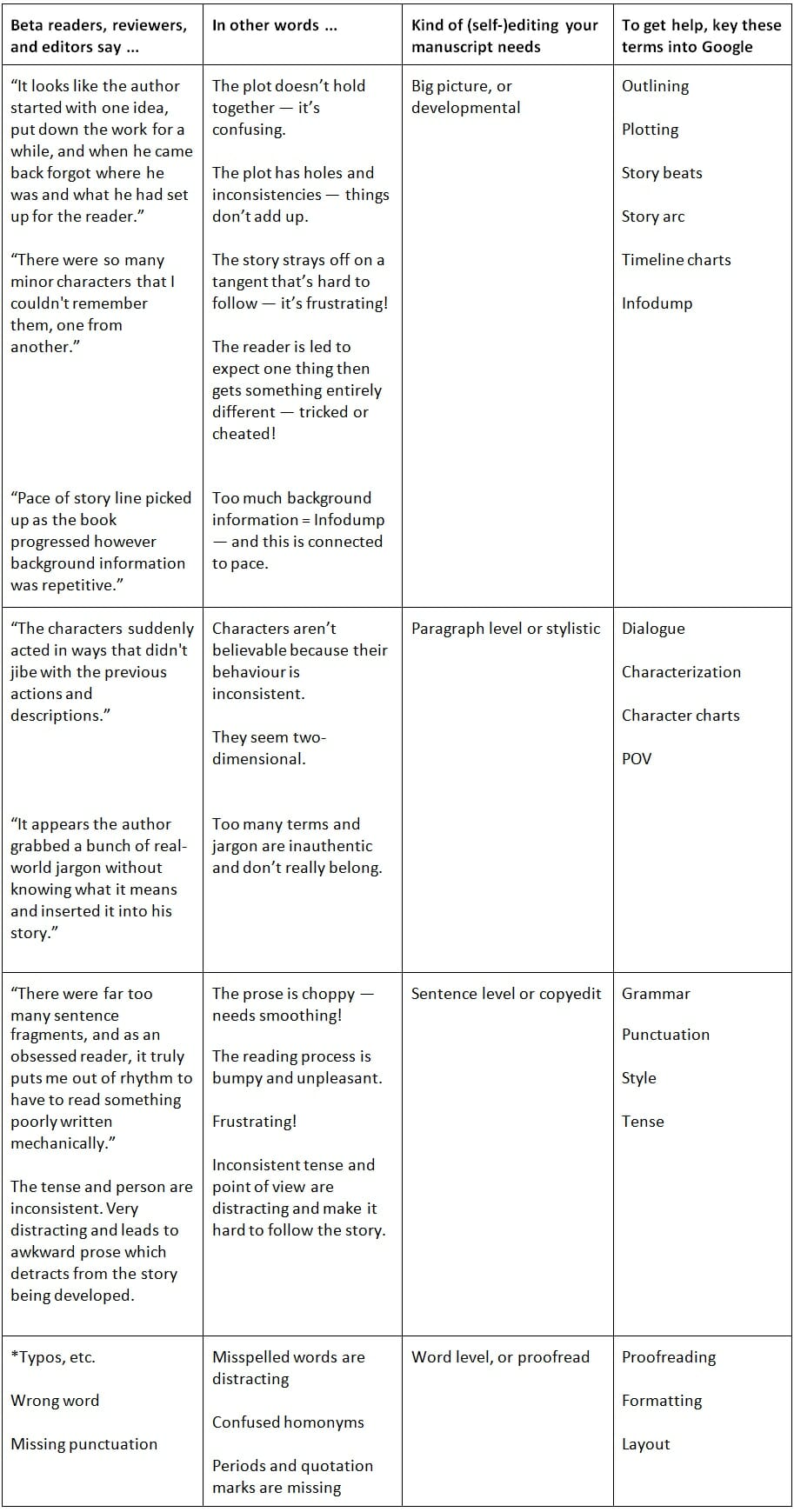
By Corina Koch MacLeod and Carla Douglas
“I know I need to edit my book, but I just don’t know where to begin.” — Indie Author
Step 1: Start with the Reader
We hear this comment frequently from self-publishing authors. Completing a book-length work is exhausting, and the last thing you want to hear when you finish your first draft is that you need to start again, this time with revisions.
You might not realize it, but the place to begin is right in front of you — it’s the reader you’ve had in mind since you began your first draft. That reader is talking to you, and if you can figure out exactly what he’s saying, he can act as your guide in the revision, or self-editing, process.
As Hugh Howey says, “Indie authors are maniacally focused on the reader … Indie authors are doing well because they know it’s all about the reader…. It’s the reader, stupid.”
So start with the reader — the reader can direct you to the problem spots in your work, if only you’ll listen. Not only that, but careful attention to what the reader is telling you can help you improve your writing.
Where do you find readers? Well, there are your beta readers, and there are reviewers. Both are giving you feedback about your work. If you’re about to publish a book, you’ll have beta reader comments to work from. If you’ve published a book already, then you might also have reviews to scour for information.
Finally, if you haven’t previously published a book and you don’t have beta readers yet for your current work, don’t despair. You can read others’ reviews … and learn from their mistakes!
The point is, the information is out there. But you need to learn how to use it.
Step 2: Do Things in the Right Order
The Editing Continuum
In her book, The Indie Author’s Guide to Book Editing: How to Find, Hire, and Work with the Right Editor for Your Manuscript, Sarah Kolb-Williams points out that the order of things matters. A big-picture edit, for example, needs to happen before a word-level edit. In other words, when you’re at the beginning of the editing process, typos should be the least of your concerns.
We said something similar in our post last month: order matters, and as you begin the editing process, you’ll save yourself time and endless frustration if you keep this order in mind:
Big-picture —> Paragraph level —> Sentence level —> Word level
If it helps, try thinking of the editing continuum as something similar to the order of operations in arithmetic. If you perform addition and subtraction before addressing division and multiplication, you’ll end up with a meaningless jumble. Similarly, if you attend to spelling and punctuation or dialogue and characterization before you’ve resolved issues in the plot, your results will be disappointing at best.
Recap:
- Focus on the reader and what he says he likes about a book — and pay special attention to what he doesn’t like.
- Order matters (see above). Don’t even think about correcting typos until you’ve got your big-picture and paragraph level ducks in a row.
Keeping these two items in mind will position you to use valuable reader feedback to your best advantage.
Step 3: Use Reviews to Improve Your Writing
Interpreting Reviews
At last, you’re ready to apply feedback to your manuscript. This is the hard part. You know where to find feedback and you know the order of revisions. We can hear you asking, “What now?”
When beta readers, readers, reviewers and editors—editors are readers, too!—offer constructive feedback, what are they actually telling you, and how can you use that information to improve your writing?
It’s possible to read what reviewers say and figure out what kind of attention your manuscript needs. Situating your manuscript on the editing continuum will also help you to determine the order in which to address things.
We searched through reviews on Amazon for examples of constructive feedback. Readers won’t necessarily tell you that you need to focus your attention on in a big-picture edit, for example, but they may suggest it. The table below interprets examples of reader feedback, so that you can see how you might identify what you need to improve on.
Once you know what readers are telling you, you can do something about it. The Google search engine is your friend, here. There is lots of great information about the craft of writing fiction on the internet. In the right column of the table, we’ve suggested some search terms you can use to find information that will help you.
Quotes from current reviews on Amazon.com

*Note: As we searched the Amazon reviews for examples of the four levels of editing, we encountered surprisingly few references to typos and spelling errors. This wasn’t the case even a year ago, when comments about careless proofreading were frequent. As we’ve said before, the landscape is changing — self-publishing authors are listening, and they’re taking measures to produce professional, polished books.
How to Use this Information
You’ve received some great reader feedback, or you’ve found reviews of others’ work that might also apply to yours. And, after identifying the trouble spots in your writing, you’ve found relevant resources to help you sort things out in your manuscript.
You’re on your way.
But making revisions is slow and difficult work — don’t try to rush things. Acknowledge that your book will take time to develop. Your attention to detail now will pay off later. Keep in mind, too, that integrating all this information is complex, and it may take more than one try to get it right.
Tackle items one item at a time in an order that makes sense — straighten out the plot and fill in the holes, for example, then address pacing. Through experience and practice you’ll learn that you can’t achieve the pace that will keep a reader engaged unless you dismantle all the infodumps standing in the way.
Yes, there’s a lot to learn and it’s hard work, but if you listen to what readers are telling you, you’ll become more aware of your writing strengths and weaknesses, and ultimately, you’ll also become a better writer.
Photo: bigstockphoto.com. Amazon links contain my affiliate code.

